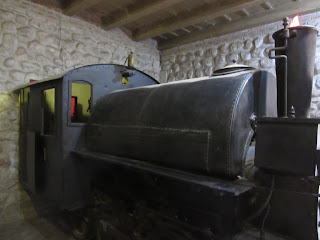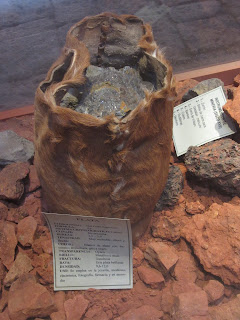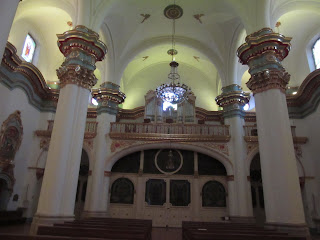After a three hour bus ride from Sucre, we arrived in Potosí, a city founded by the Spanish conquistadores in 1545 when the world's largest silver deposit was discovered in its Cerro Rico or 'Rich Hill.' No one is certain how much silver has been extracted from the red, dusty mountain over its four centuries of productivity, but a popular boast was that the Spanish could have constructed a silver bridge to Spain and still had silver left to carry across it!
After dumping our bags at The Koala Den, one of the worst places we stayed in all trip, we headed directly to the gorgeous Plaza 10 de Noviembre, situated in the heart of the city. Many of the city's colonial-era buildings bordered the lovely square.
The building served as the national mint from the conquest, through the independence of Bolivia, until it was no longer economical to run as a mint. As its walls were more than three feet thick, it wasn't surprising to learn that the mint also served as a prison, a fortress and as the headquarters of the Bolivian army.
Apart from the beauty of the building itself, the museum contained a lot of historical treasures. We were surprised to learn the mint had a substantial Art Gallery.
It had a fascinating selection of religious paintings from the Potosí school or style of art done mostly by anonymous artists in the 16th century. The artists weren't able to sign their artworks because they were illiterate. True to its name, the Marian Gallery only included paintings of the Virgin Mary.
This was but one of the five courtyards of the mammoth building. During colonial times it had been a stable for the mules who worked the machines in the mint.
In another room were 19th century scales used to verify the weight of the minerals.
In the last half of the 20th century, Editorial Potosí was a major publishing company in Bolivia. The company leased part of the Casa de Moneda while the mint was transitioning into a museum. Many notable books were printed on this Intertype Press which was manufactured in the US and used until 1950. It had to be left in the printing room because it was too big to move!
In colonial times, safes with faces of people on the front were used in churches in lieu of collection plates. Twelve mechanical bolts in the safe were activated with one key. As many pirates plied the routes between Bolivia and Spain, the safe's top was covered with calf skin to disguise its contents.
They were then placed in rolling machines which further reduced them to just 1 cm thick.
I was surprised to learn from the guide that the 'S' and the 'I' in the $ sign came from the last two letters in Potosí. A new, useless fact for you!
The guide said a machine like this one with rotary blades is still used to this day to stamp special coins.
The gold and bronze crucifixion of Christ was from the 19th century.
The coffins contained the bodies of former presidents and singers, etc.
Through a small window, we caught a glimpse of Cerro Rico at long last!
Steven was asked if he wanted to play the 19th century organ from France that had foot pedals! Even though he took piano lessons as a child and can still play it and the guitar, he demurred. I, on the other hand, have no musical ability whatsoever. When was the last time you were invited to play an instrument that was that old, let alone being able to touch it in a church or museum?!
From the roof, we had lovely views of the city.
The mighty Cerro Rico was just visible in the distance as it was the first time it had rained in ages in Potosí.
The principal bell weighed three tons and came from Italy in 1807.
Cerro Rico, rich in natural resources, once produced so much silver it pushed Potosí onto the world stage, becoming the wealthiest city in the Americas. More than 80 churches were constructed and Potosí's population swelled to more than 200,000, making it one of the largest cities in the world. However, due to lack of infrastructure and inadequate safety equipment, it is estimated that over the three centuries of colonial rule from 1545-1825, as many as eight million indigenous Bolivians and African slaves lost their lives extracting silver from the mountain’s veins, making it one of the most dangerous jobs in the world.
After dumping our bags at The Koala Den, one of the worst places we stayed in all trip, we headed directly to the gorgeous Plaza 10 de Noviembre, situated in the heart of the city. Many of the city's colonial-era buildings bordered the lovely square.
The plaza's Arcos (Arches) de Cobija were striking even though the skies were gloomy.
Despite the past abundance of precious metals, Potosí is now one of the poorest cities in South America. I read that many of Bolivia’s men have no choice but to work the unstable, mineral-depleted mines in order to scrape together enough money to feed their families. Even though most of the operations in Cerro Rico today are in the control of miner-owned cooperatives, working conditions have changed little from the colonial period.
We had specifically tailored our itinerary to be in Potosí on November 14th as the Lonely Planet guidebook stated that only twice a year - May 16th and November 14th - seven of the city's religious museums open their doors to the public and guides in traditional period dress narrate the city's colonial-era history. More on that and our visit to the plaza's Cathedral Basilica of Our Lady of Peace, below, later.
The Scales of Justice were moving in the stiff breeze atop City Hall.
As the Casa Nacional de la Moneda or National Mint was known as Potosí's star attraction and one of South America's finest museums, we walked to the building which took up an entire city block in the center of town for the guided tour. It was built between 1753 and 1773 to control the mining of colonial coins.
I was excited when I saw the woman dressed in period costume by the courtyard, thinking the Night of the Museums also included the mint.The building served as the national mint from the conquest, through the independence of Bolivia, until it was no longer economical to run as a mint. As its walls were more than three feet thick, it wasn't surprising to learn that the mint also served as a prison, a fortress and as the headquarters of the Bolivian army.
As we were ushered into the courtyard, we were 'greeted' by a stone fountain and a freaky mask of Bacchus, hung there in 1865 by a Frenchman for reasons known only to him. It has since become a town icon known as the mascaron, a face whose function was originally to frighten away evil spirits so that they would not enter the building.
Railway service began in Bolivia in April, 1892. The Pacamayo train, one of the first locomotives to operate between the southern part of Bolivia and Chile, has been on display at the museum since April, 1948.Apart from the beauty of the building itself, the museum contained a lot of historical treasures. We were surprised to learn the mint had a substantial Art Gallery.
It had a fascinating selection of religious paintings from the Potosí school or style of art done mostly by anonymous artists in the 16th century. The artists weren't able to sign their artworks because they were illiterate. True to its name, the Marian Gallery only included paintings of the Virgin Mary.
Our guide explained that since indigenous Bolivians believed the Virgin Mary was Pachamama or Mother Earth, she was always depicted as being triangular in shape. That shape also represented the outline of Cerro Rico, the mountain overlooking the city.
Our guide told us that the silver mines were first found by a local Inca in 1544 who, while searching for an escaped llama, stopped to build a fire at the base of the mountain known in Quechua as Potojsí, meaning 'thunder' or 'explosion.' The fire grew so hot that the earth beneath it started to melt and shiny liquid oozed from the ground. Of course, the artist took some liberties as it showed the Inca emperor having discovered the wealth of silver while he was camping! The circle represented the world with Potosí in the center.
The Baroque-style oil painting of the Virgen de la Merced or Virgin of Mercy was painted by an anonymous artist in the 17th century.
This lovely oil, called the Virgen de la Guadulupe, was painted by Luis Nino, an 18th century indigenous artist. I just discovered that our city's Denver Art Museum has a painting by the same artist from Potosí called the Virgin of the Victory of the Malaga! I hope Steven and I will see it when it's next displayed.
Our guide informed us that the next room, which contained colonial paintings of battles and religious paintings, was used for meetings. Especially remarkable were the oils painted and signed by Melchor Perez de Holguin, a local artist from the late 17th century.
The frames were made in the museum.
As we proceeded to the actual mint, our guide remarked the Spanish decided to produce coins in 1572. It took fifteen years to construct the three floors of the mint, the largest building in Potosí. The coins made at the mint were used all over the world.This was but one of the five courtyards of the mammoth building. During colonial times it had been a stable for the mules who worked the machines in the mint.
There were ten smelting rooms for the silver and one for gold; just one was maintained for visitors. Mercury was added to the silver to get rid of the impurities. As mercury was heavier, the silver and gold then rose to the top, a process that took two hours. The silver was then put into ingots.
Contact with deadly levels of mercury and smoke caused heavy loss of life. So many workers died from mining accidents, silicosis pneumonia and in the smelting rooms that the Spanish imported millions of African slaves to augment the labor force. When the Spanish learned of the enormous wealth buried in the mountain of Potosí, thousands of indigenous slaves were pressed into service, and large-scale excavations began.
The Viceroy of Toledo instituted a law in 1572 that required all indigenous and African slaves over the age of 18 to work 12-hour shifts. They would remain underground without seeing daylight for four months at a time, eating, sleeping and working in the mines. When they emerged from a 'shift,' their eyes were covered to prevent damage from the bright sunlight.
The room contained a huge array of silver and gold minerals.
A French smelting oven used in the 19th and 20th centuries:
One of the former smelting areas was transformed into a chapel. At the height of Potosí's wealth and power in the 17th and 18th centuries, there were many churches as well as ten convents in the city.
These tiny figures were mummies from the 18th and 19th centuries!
The guide explained that many workshops in Potosí made silver objects mostly for the town's upper classes. Here were some examples of their exquisite workmanship.
More weights and measures:
During the 16th century, coins were stamped one at a time. Up to three thousand a day were made this way.In colonial times, safes with faces of people on the front were used in churches in lieu of collection plates. Twelve mechanical bolts in the safe were activated with one key. As many pirates plied the routes between Bolivia and Spain, the safe's top was covered with calf skin to disguise its contents.
For more than a hundred years, coins made in Potosí were irregular and cut by chisel and minted by hammer. Then the Spanish authorities decided to provide new and modern machinery called Metal Rolling Mills for making perfect coins. Mule-driven wooden cogs were used to flatten the silver ingots to 25 cm long by 45 cm wide by 15 cm thick.
The first coins were made for Spain in Potosí and were hammered ones until the process became more refined. The most important factor was the uniformity of their weight, not their shape. They were 95% silver and 5% copper.
In 1867, the Bolivian government replaced mule power with steam engines from Pennsylvania. That resulted in the first Bolivianos being minted from then until 1902. Ironically, the 5 Bolivianos coin, is now made from cheaper materials like zinc and copper in Canada! Other currency is made in Chile and France prints their bills.
1909 saw the upgrade to electrical machines.
The amazingly lifelike models were working on blank cutters, metal dippers and other machines.
The guide said a machine like this one with rotary blades is still used to this day to stamp special coins.
During the almost two-hour long tour of the mint, we got a good sense of the impact Cerro Rico had on Potosí, its inhabitants and the rest of the world as well as viewing some attractive art pieces.
Interesting graffiti as we walked back toward the Cathedral:
As I mentioned above, we had planned to be in Potosí that night specifically for its Night of Museums which would include tours of the Cathedral and other religious museums. It was a real downer for me when we learned that the tourist information we had was old and most religious museums wouldn't be open at all. However, a young staff member at the cathedral took pity on us and kindly showed us around as we couldn't wander by ourselves. The Gothic altar from 1836 depicted a painting of Christ, not a crucified Christ. She explained it is used on Holy Days and other special days.
I gathered I was supposed to have known that this painting was of Santiago and his Martyrs under the horse. However, I had no knowledge of him at all.
The guide proudly said the coat-of-arms on the altar was 12% gold proof.
The statue of Mary of Immaculate Conception was 'only' made of plaster.
The Virgin of Copacabana was considered to be the patron saint of Bolivia. We were told she had natural hair and a silver crown.
One of the most gruesome sights were the bones of Spanish people behind this cabinet. The church had been built above an old cemetery and the bones were revealed in 2009 when the church had been renovated.
A view from the high choir:
This device was used to amplify singers' voices throughout the church.Steven was asked if he wanted to play the 19th century organ from France that had foot pedals! Even though he took piano lessons as a child and can still play it and the guitar, he demurred. I, on the other hand, have no musical ability whatsoever. When was the last time you were invited to play an instrument that was that old, let alone being able to touch it in a church or museum?!
The guide said there were 'just' 98 steps up to the bell tower. We climbed it slowly as the city's altitude was over 13,400 feet high.
The mighty Cerro Rico was just visible in the distance as it was the first time it had rained in ages in Potosí.
The principal bell weighed three tons and came from Italy in 1807.
We spent a few minutes at the Iglesia de la Merced, built between 1555 and 1687, as it was also supposed to be part of the Museums' festivities that night.
Over the altarpiece was a beautiful silver arch.
The church was also notable for its gorgeous wooden ceiling.
I don't think we'd ever seen a carved pulpit quite like this one.
What a lovely sunset as we left the church to walk along Calle Quijarro, a street 'that winds between a wealth of colonial buildings, many graced by old family crests' according to our guidebook.
The description caught our fancy but the reality was very different as there was only one family crest to be seen!
The only family crest:
This was the street's only lovely colonial building that we saw. The rest of the street was appallingly ugly with graffiti on every building.
We had reserved a room with a private entrance and bathroom but this dorm room was what we were given when we got back that evening after touring the mint and churches. We were not too happy with booking.com as our room in no way lived up to its description. We were just thankful no one else joined us and we were only in Potosí that one night!
Next post: On to Uyuni to arrange a tour of the famous Salar de Uyuni.
Posted on March 16th, 2018, from Littleton, Colorado.

















































































































No comments:
Post a Comment